The John Seigenthaler Pedestrian Bridge in Nashville is a must-see, its gracefully spanning the Cumberland River to connect downtown with East Nashville. Originally a railroad bridge built in 1909, it’s now a pedestrian haven offering breathtaking views of the city skyline and river. Walk across and feel the blend of history, urban charm, and natural beauty. Whether you’re catching a sunrise, snapping photos at sunset, or admiring the city lights at night, every step tells a story. Why is it so beloved? Come see for yourself—it’s more than a bridge; it’s a Nashville experience.
What is the Pedestrian Bridge in Nashville
The pedestrian bridge in Nashville is the John Seigenthaler Pedestrian Bridge, a historic truss bridge spanning the Cumberland River and connecting downtown to the East Bank. Restored in 2003 and closed to vehicle traffic, it’s a popular spot for walking, jogging, cyclists, and photography with iconic views of the downtown skyline and Nissan Stadium.
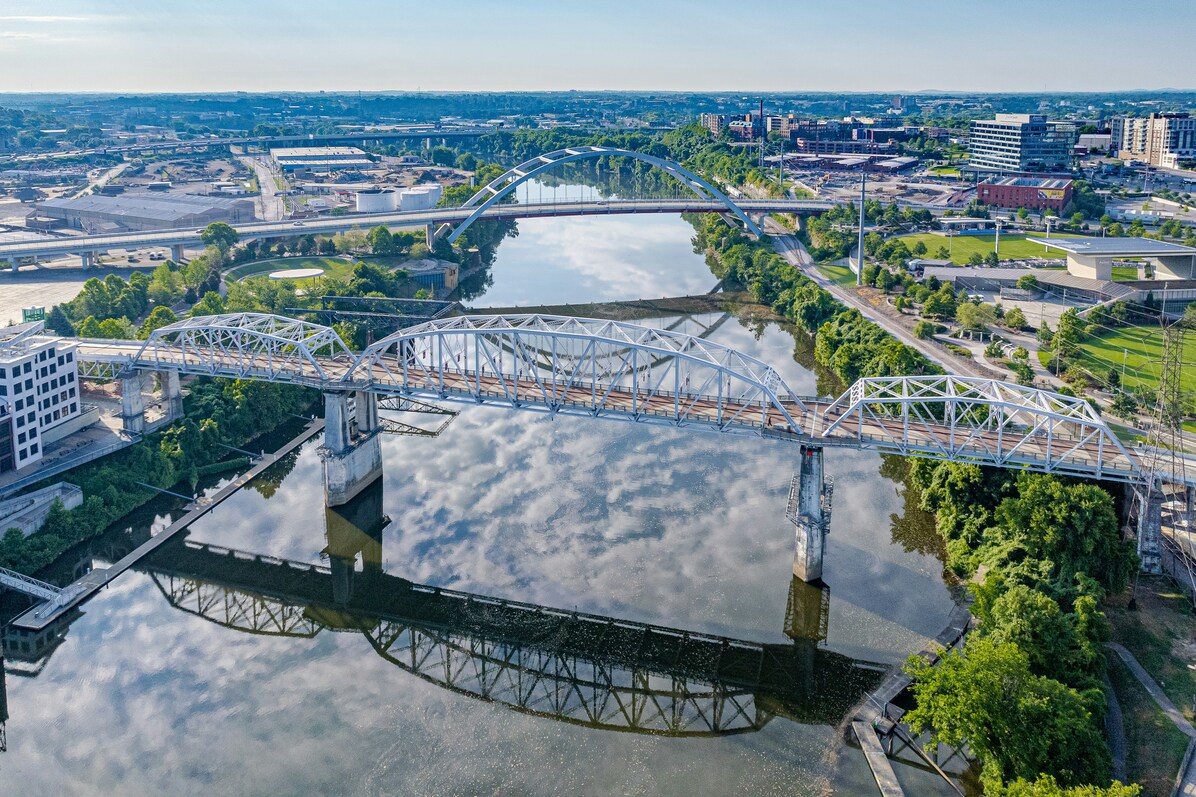
The John Seigenthaler Pedestrian Bridge: Connecting Nashville’s Heart and Soul
Spanning the Cumberland River, the John Seigenthaler Pedestrian Bridge was one of the first bridges in the country designed exclusively for automobile traffic. Today, it stands as one of the most scenic pedestrian thoroughfares in the city. Originally a truss bridge built to connect downtown Nashville to the residential suburbs of East Nashville, it was closed to vehicular traffic in 1998 due to structural concerns. However, it was preserved and renovated as a pedestrian bridge, reopening in 2003.
Spanning 3,150 feet, the bridge offers an outstanding vantage point for viewing the Nashville skyline and Cumberland River. It is frequently used by pedestrians and cyclists, making it a popular spot for tourist photos, community events, and even part of the course for the Country Music Marathon. It’s also a popular viewing area for Nashville’s Fourth of July fireworks display and serves as a gathering place for locals and visitors alike. Whether you’re enjoying a leisurely walk, a brisk jog, or simply taking in the stunning panoramic views of downtown Nashville, the bridge is a perfect place to experience the heart of the city.
From Rails to Trails
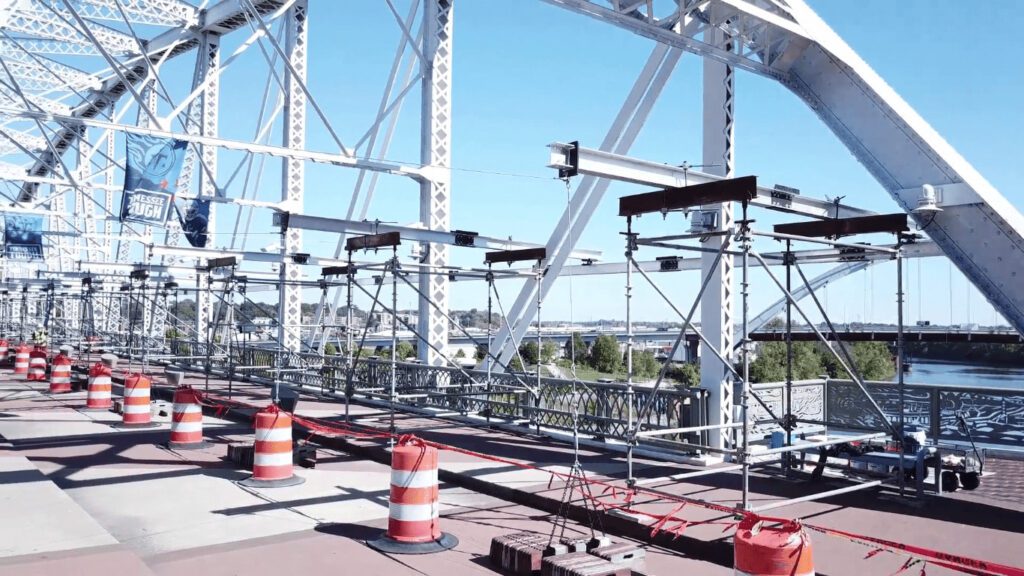
Originally known as the Sparkman Street Bridge, this iconic structure was built for $475,000 and opened on July 5, 1909, replacing the earlier Shelby Avenue Bridge. Designed by engineer Howard M. Jones for the Nashville, Chattanooga, and St. Louis Railway, it was a groundbreaking feat as the first bridge in North America to feature concrete arched trusses. Its light grey concrete and steel painted black gave it a striking presence over the Cumberland River.
For decades, it served as a vital rail link, carrying Tennessee Central Railroad tracks and later CSX rail traffic. In 1998, it was restored and repurposed for pedestrian use, becoming the Shelby Street Pedestrian Bridge. Today, its architectural drawings are preserved, and its legacy lives on in the Metro Transportation Offices.
A New Life to Nashville’s Icon
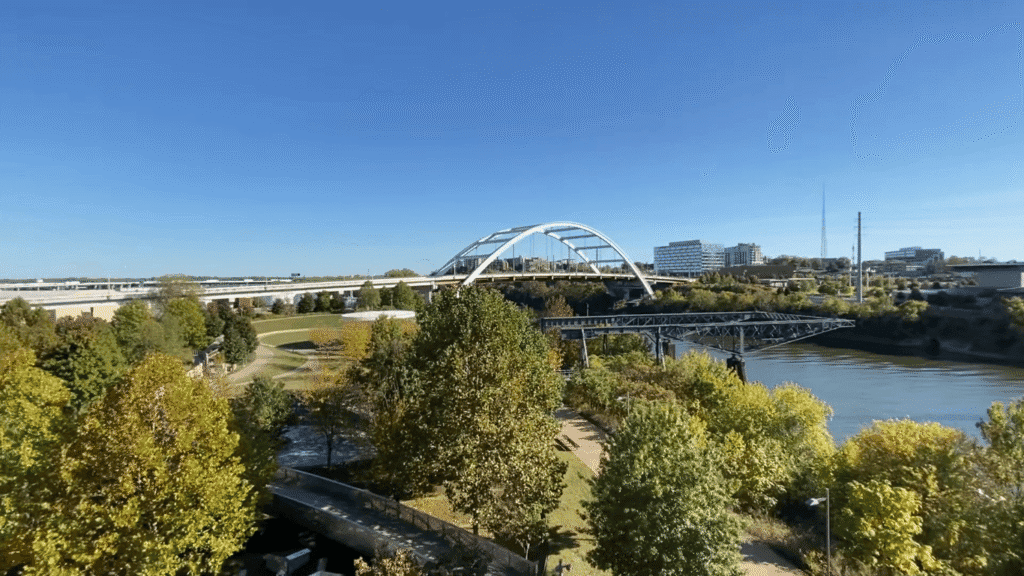
A Bridge Reborn
The bridge’s transformation into a pedestrian walkway turned it into a greenway feature, offering amazing views of the Cumberland River, downtown skyline, and East Nashville. Its historic truss design and scenic location make it a beloved spot for both locals and visitors, seamlessly connecting the city’s past and present.
A Landmark of Innovation
The John Seigenthaler Pedestrian Bridge was admitted to the National Register of Historic Places due to its unique truss design. While the Jefferson Street Bridge was considered for preservation, it was rejected due to its poorer condition and demolished in 1990 to make way for a new bridge to handle more traffic. Today, the John Seigenthaler Pedestrian Bridge stands as a famous, iconic landmark, linking downtown Nashville to residential suburbs and providing outstanding views of the city skyline. Its role as a linking structure and its unique design make it a cherished part of Nashville’s heritage, bridging history and modernity.
Renaming and Legacy
In April 2014, Nashville renamed the Shelby Street Bridge as the John Seigenthaler Pedestrian Bridge, honoring John Seigenthaler—a renowned journalist, civil rights advocate, and longtime editor of The Tennessean. His legacy is inseparable from a defining moment in 1954, when he physically intervened to stop Gene Bradford Williams, a suicidal man, from jumping into the Cumberland River. Williams had taunted the newspaper to “send a reporter and photographer if you want a story” before his near-fatal 100-foot plunge. Seigenthaler’s quick action, alongside police, saved Williams, who later muttered, “I’ll never forgive you.”
Ironically, Seigenthaler often joked that his Father Ryan High School classmates dismissed the bridge as the place “rats go back home to East Nashville.” The renaming not only commemorates his bravery but also his lifelong fight for Civil Rights and First Amendment freedoms. Today, the bridge—accessible to pedestrians and cyclists via 3rd Ave S—stands as both a historic landmark and a lively public space. Its blend of beauty, history, and civic purpose reflects Seigenthaler’s enduring impact on Nashville, turning a once-derided structure into a symbol of resilience and unity.
Restoring History: The Bridge’s Repair Journey
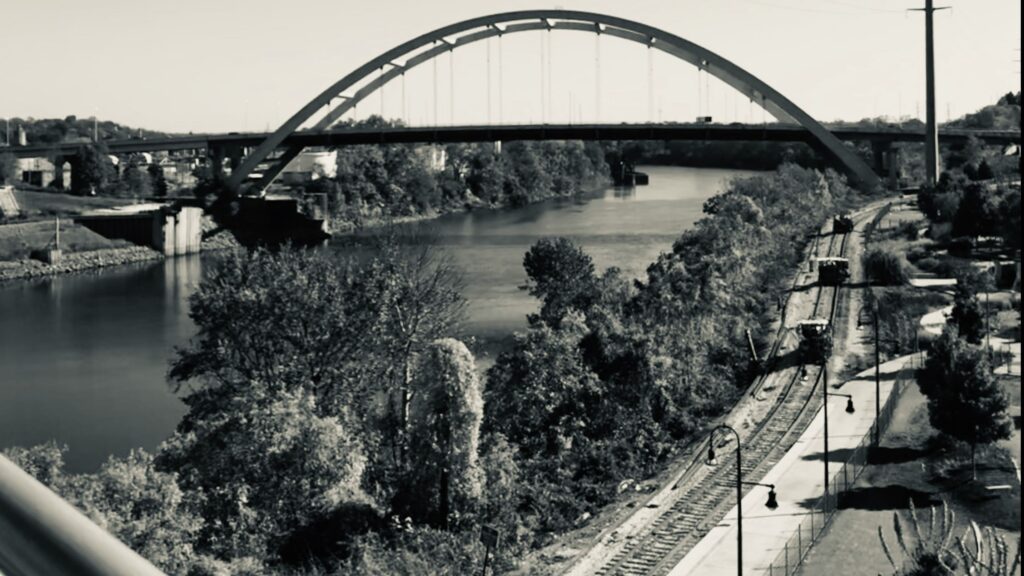
The John Seigenthaler Pedestrian Bridge has undergone multiple repairs over the years to maintain its structural integrity. Key efforts included addressing worn concrete surfaces, reinforcing steel work, and using materials like gunite for restoration. These repairs have ensured the bridge’s longevity and transformation into a beloved pedestrian landmark.
History and Transformation
After being in use for twenty-five years, issues with the concrete on the Sparkman Street Bridge became evident. Between 1927 and 1930, the worn surfaces of the concrete were chipped away and replaced with gunite to strengthen the structure. Fast forward thirty years later, and the bridge required repair work once again. This time, the Standard Engineering Company from Albany, New York, was brought in to address the weathered bridge. They delegated the steel work to the Nashville Bridge Company as part of the project. Interestingly, during the same period, repairs were also carried out on the Jefferson Street Bridge, showcasing the era’s focus on maintaining critical infrastructure.
Refurbishment and Features
In 1992, state inspectors declared the bridge in poor condition, leading to its closure to vehicular traffic by 1998. Originally slated for demolition, the bridge was saved due to its aesthetic, architectural, and historical significance. Inspired by the success of the Walnut Street Bridge in Chattanooga, it was converted into a pedestrian bridge as part of urban renewal efforts.
During its refurbishment, key features were added, including an elevator, ramps, and stairways for accessibility. The center lane, 15 feet (4.6 m) wide, was designed to accommodate bicycles and even a trolley, though the bicycle lane was later abandoned. The 10-foot-wide (3.0 m), elevated boardwalk-style sidewalks offer scenic pedestrian overlooks with metal railings featuring artistic renderings of the history and life along the Cumberland River. Dramatically lit at night, the bridge is now part of the Metro Nashville Greenway system, administered by the Parks Department, and serves as a vibrant public space for locals and visitors alike.
Featured in Music Videos

The John Seigenthaler Pedestrian Bridge, with its iconic status as a Nashville landmark, has been a popular backdrop for country music videos. It gained fame when Big & Rich shot their first hit single, “Save a Horse (Ride a Cowboy)”, entirely on the Shelby Street Bridge. In 2007, Emerson Drive filmed scenes under the bridge for their hit single, “Moments”. The bridge also appeared in Dolly Parton’s 2015 video, “Together You and I”, and Thomas Rhett’s “Crash and Burn”. Additionally, Aaron Cole’s music video, “Yours to Use”, was filmed on the bridge during a night shooting. Beyond music, the bridge made headlines when Jon Bon Jovi famously prevented a woman from committing suicide there, adding to its storied legacy.
A Picturesque and Photogenic Landmark

Visitors often stroll across this picturesque bridge, camera or phone in hand, pausing midway to snap a fantastic selfie with the Nashville skyline as the perfect backdrop. A familiar feature in countless music videos, the bridge’s vantage point has made it a favorite spot for photographers and tourists alike. As Rachael Hood, Senior Editor, points out, the bridge—once known as the Shelby Street Pedestrian Bridge and Sparkman Street Bridge—boasts 48 spans of steel trusses and reinforced concrete trusses, the only such concrete trusses in Tennessee. Along the way, pedestrians can stop to soak in the stunning views of the Cumberland River and admire the bridge’s unique charm.
A Scenic and Convenient Walk
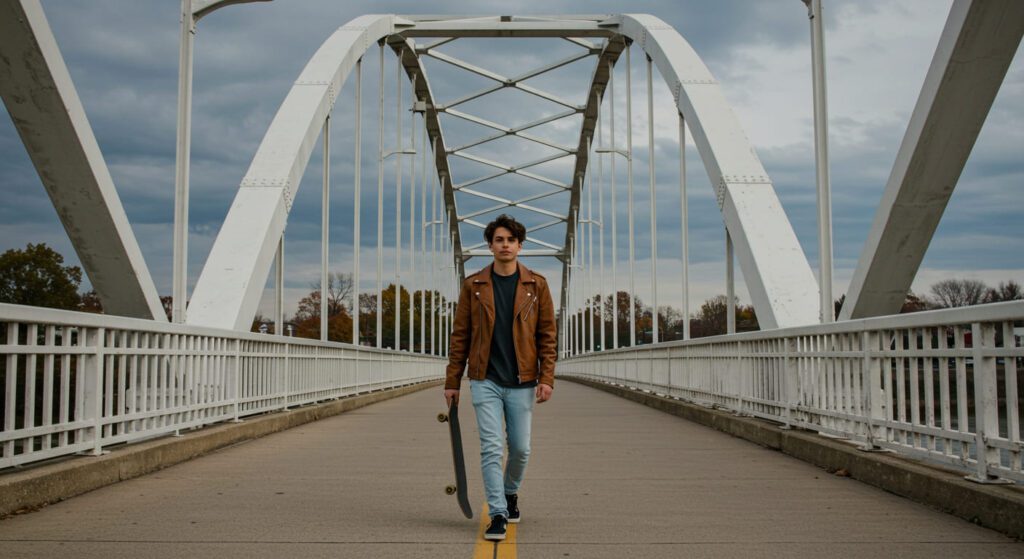
The John Seigenthaler Pedestrian Bridge offers a short, peaceful walk connecting downtown Nashville to the residential suburbs of East Nashville – one of the strangest yet most charming contrasts in the city. Starting near Lower Broadway and the lively Honky Tonks, it’s a nice little walk with stunning views of the downtown skyline, the color-changing Gateway Bridge, and the Korean War Veterans Memorial Bridge – perfect for a couples New Year celebrations, a teen trip in budget, or a memorable night out in Nashville. Whether it’s day or night, the bridge feels serene, much like the Walnut Street Pedestrian Bridge in Chattanooga, but with a unique Nashville vibe that keeps visitors coming back.
Both sides of the bridge are vibrant and touristy, making it a good place to walk or bike. On the downtown side, you’re just a short walk from Broadway, where you can stop by Mike’s Ice Cream or explore the Honky Tonks. On the East Nashville side, you’ll find quieter, residential areas perfect for a leisurely stroll. Whether you’re a local or a visitor, the bridge is a must-visit spot for its scenic beauty and convenient location.
Location and Accessibility
The John Seigenthaler Pedestrian Bridge is located at Nashville, TN 37201, United States, near the intersection of Broadway and 1st Ave S in the heart of the city. Easily accessible from the bustling downtown area, it’s just a short walk from popular attractions and is conveniently close to Interstate 24 (I-24). For locals and visitors, reaching the bridge is simple—take the Broadway exit to the west, and you’ll find yourself at this iconic structure in no time.
Opening and Closing Hours
The bridge is a 24/7 public thoroughfare, allowing pedestrians to enjoy its beauty day or night. Its design features decorative lights that create a stunning visual spectacle, especially at sunset and after dark. Visitors are encouraged to explore the bridge at different times of the day to fully appreciate the changing vistas of Nashville’s skyline and the Cumberland River.
Proximity to Nearby Attractions
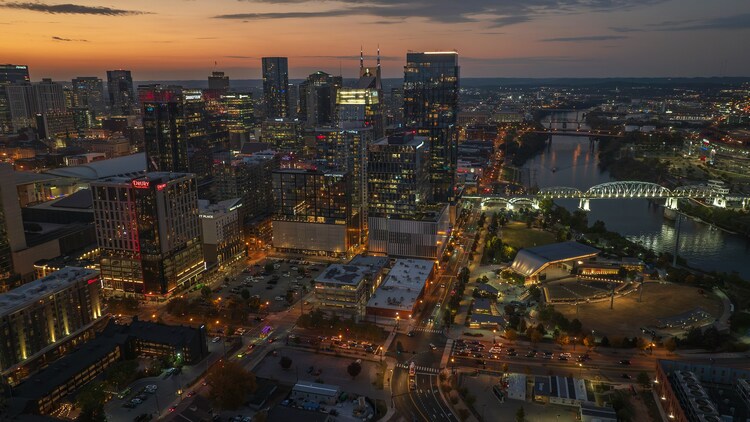
Within a three-mile radius, the John Seigenthaler Pedestrian Bridge provides easy access to a variety of cultural, entertainment, and recreational attractions in Downtown Nashville. Centrally located, the bridge serves as a gateway to the lively downtown area, including Lower Broadway, home to iconic honky-tonk bars, live music venues, and vibrant street life. Just 0.5 miles east, you’ll find Nissan Stadium, where the Tennessee Titans play and major concerts and sporting events are held.
A short walk 1 mile east leads to Cumberland Park, a waterfront park offering scenic views, play areas, and walking trails, making it a peaceful retreat for families and outdoor enthusiasts. For music lovers, the Ryman Auditorium, located 0.7 miles northwest, is a historic music venue known as the Mother Church of Country Music, hosting legendary performances and standing as a cultural landmark.
Those stunning river bridges? Just the beginning. While they make perfect photo ops, the real magic happens when you explore what’s nearby. Want ancient history with your skyline views? The Parthenon Replica delivers Greek grandeur right in Centennial Park. Need to beat the heat or rain? Discover the best indoor spots in Nashville, from vinyl-filled record shops to whiskey tasting rooms. And when you’re ready for something completely different, head 1.5 miles southwest to The Gulch – where upscale boutiques, chef-driven restaurants, and cutting-edge street art give downtown’s historic charm a modern, stylish twist that’ll surprise even longtime locals
The bridge itself is a perfect spot to relax and enjoy panoramic views of the city to the north and south. Many recommend visiting at night when the city is lit up, especially under a full moon. Nearby attractions like the Johnny Cash Museum are less than six blocks away, making it easy to explore more of what Nashville Downtown has to offer.
With its distinctive arched design and decorative lighting, the bridge adds to the city’s architectural beauty, offering scenic views of the rolling hills and skyline. It’s an ideal location for photography enthusiasts, with stunning shots available during the golden hour when the setting sun bathes the city in warm hues.
A Haven for Cyclists
The John Seigenthaler Pedestrian Bridge is a haven for pedestrians and cyclists, offering a shared space perfect for recreational activities like strolling, jogging, and cycling. Designed with a pleasant and accommodating environment, the bridge seamlessly connects Riverfront Park on the west bank to Cumberland Park on the eastern shore, extending recreational opportunities and access to green spaces and events. Whether you’re taking a leisurely stroll along the riverfront or enjoying a scenic bike ride, the bridge provides a welcoming experience for everyone.
Visitor Tips and Amenities
To fully enjoy the John Seigenthaler Pedestrian Bridge, explore its pedestrian-friendly design, perfect for a leisurely stroll. For an enchanting experience, visit during sunset or in the evening to witness the Nashville skyline illuminated against the Cumberland River.
- Wear Comfortable Footwear: The bridge is best explored on foot, so supportive shoes are essential for a pleasant walk.
- Bike Rentals: Use nearby bike rental stations to explore the surrounding areas in an eco-friendly way.
- Sun Protection: Bring water and sun protection during warm weather, as the bridge’s open design offers fresh air but little shade.
- Stay Hydrated: Carry water to stay refreshed, especially during summer months.
- Local Events: Check the local events calendar for festivals, concerts, and community gatherings held on or near the bridge.
- Art and Culture: Enjoy art installations and the bridge’s role as a hub for community gatherings and cultural events.
Frequently Asked Questions About John Seigenthaler Pedestrian Bridge
What is another name for a pedestrian bridge?
A pedestrian bridge is also commonly called a footbridge, pedestrian overpass, or pedestrian overcrossing, with each term describing structures designed for safe passage. These structures are designed solely for pedestrians to cross safely over roads, railways, or waterways.
How many pedestrian bridges are there in Nashville?
The Nashville Department of Transportation and Multimodal Infrastructure (NDOT) maintains a network totaling 407 structures across the city, which includes 353 bridges, 52 underpasses, and 2 pedestrian bridges for safe transportation. These Federally regulated underpasses are part of Nashville’s transportation network.
What is the name of the river that goes through Nashville?
The Cumberland River is one of the most beautiful natural features that flows right through the heart of Nashville, Tennessee, creating scenic waterfront views throughout the city.
How old is Shelby Street Bridge, Nashville?
The Shelby Street Pedestrian Bridge, formerly and originally named the Sparkman Street Bridge, was built between 1907-09. Now called the John Seigenthaler Pedestrian Bridge, this historic bridge connects downtown Nashville to the residential suburbs of East Nashville.
How much did it cost to build the John Seigenthaler Pedestrian Bridge?
Originally constructed as the Sparkman Street Bridge in 1909, the bridge cost approximately $475,000 to build. After decades of use, it was renovated and transformed into a pedestrian-only bridge, reopening in 2003 as a key part of Nashville’s urban landscape.
Where is the pedestrian bridge in Nashville?
The John Seigenthaler Pedestrian Bridge, originally known as the Sparkman Street Bridge, is located one block south of Broadway in Nashville. Built and opened on July 5, 1909, it was constructed at a cost of $475,000, connecting Shelby Avenue to Sparkman Street across the river.
How long is the pedestrian bridge in Nashville today?
The John Seigenthaler Pedestrian Bridge in Nashville spans 3,150 feet long across the Cumberland River. This bridge offers the prettiest view of downtown, especially after dark when city lights illuminate the skyline.
What is the history of the pedestrian bridge in Nashville?
The John Seigenthaler Pedestrian Bridge, originally known as the Sparkman Street Bridge, was built and opened on July 5, 1909. Constructed one block south of Broadway, the bridge cost $475,000 and was designed for connecting Shelby Avenue to Sparkman Street across the river.
Can you walk across the Nashville bridge?
Yes! Spanning the Cumberland River, the John Seigenthaler Pedestrian Bridge is also known as one of the world’s longest pedestrian-only bridges where you can walk freely across. It connects downtown Nashville’s west bank at Riverfront Park to the eastern shore at Cumberland Park over the river.
Where to park to walk the John Seigenthaler pedestrian bridge?
The John Seigenthaler Pedestrian Bridge does not offer on-site parking. The closest parking to the site in Nashville includes 134 2nd Avenue South, Four Seasons Garage – 150 2nd Ave S, Pinnacle Garage – 150 3rd Ave S, 222 Hines Garage – 222 2nd Ave S, SoBro Tower Garage – 210 3rd Ave S, and Smead Lot – 110 4th Ave S, all within walking distance of the bridge entrance.
Conclusion
Walking across the John Seigenthaler Pedestrian Bridge is an experience that stays with you. As someone who has strolled its length countless times, I can confidently say it’s one of Nashville’s most rewarding treasures. The bridge’s architectural elegance and panoramic views of the Cumberland River and downtown skyline create a sense of awe, whether you’re visiting for the first time or the hundredth.
What makes this bridge truly special is how it seamlessly blends urban design with natural beauty. It’s not just a pathway—it’s a cultural connector, linking the vibrant energy of Lower Broadway to the serene retreat of Cumberland Park. I’ve watched sunsets here that paint the sky in warm hues, and I’ve seen the city lights reflect off the river at night, creating a magical atmosphere.
Added to the National Register of Historic Places in 1998, the bridge is a testament to Nashville’s commitment to preserving its heritage while fostering community spaces. Whether you’re a local or a visitor, the John Seigenthaler Pedestrian Bridge offers a multifaceted experience that enhances the city’s charm.
Plan your visit and take your time to embark on this journey. It’s more than just a walk—it’s a connection to the heart and soul of Music City, USA

